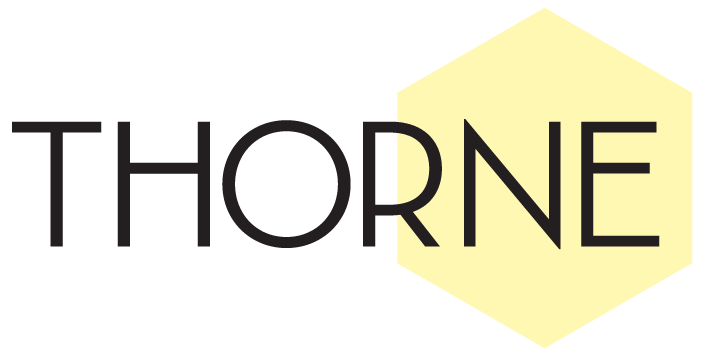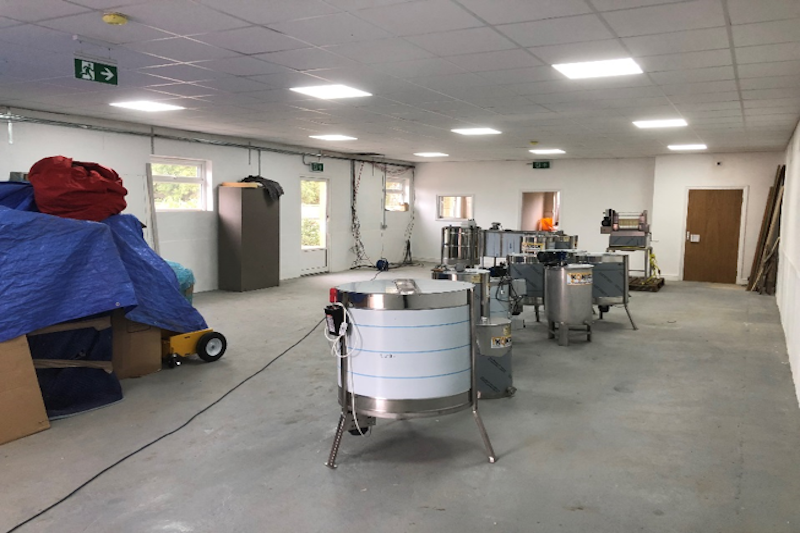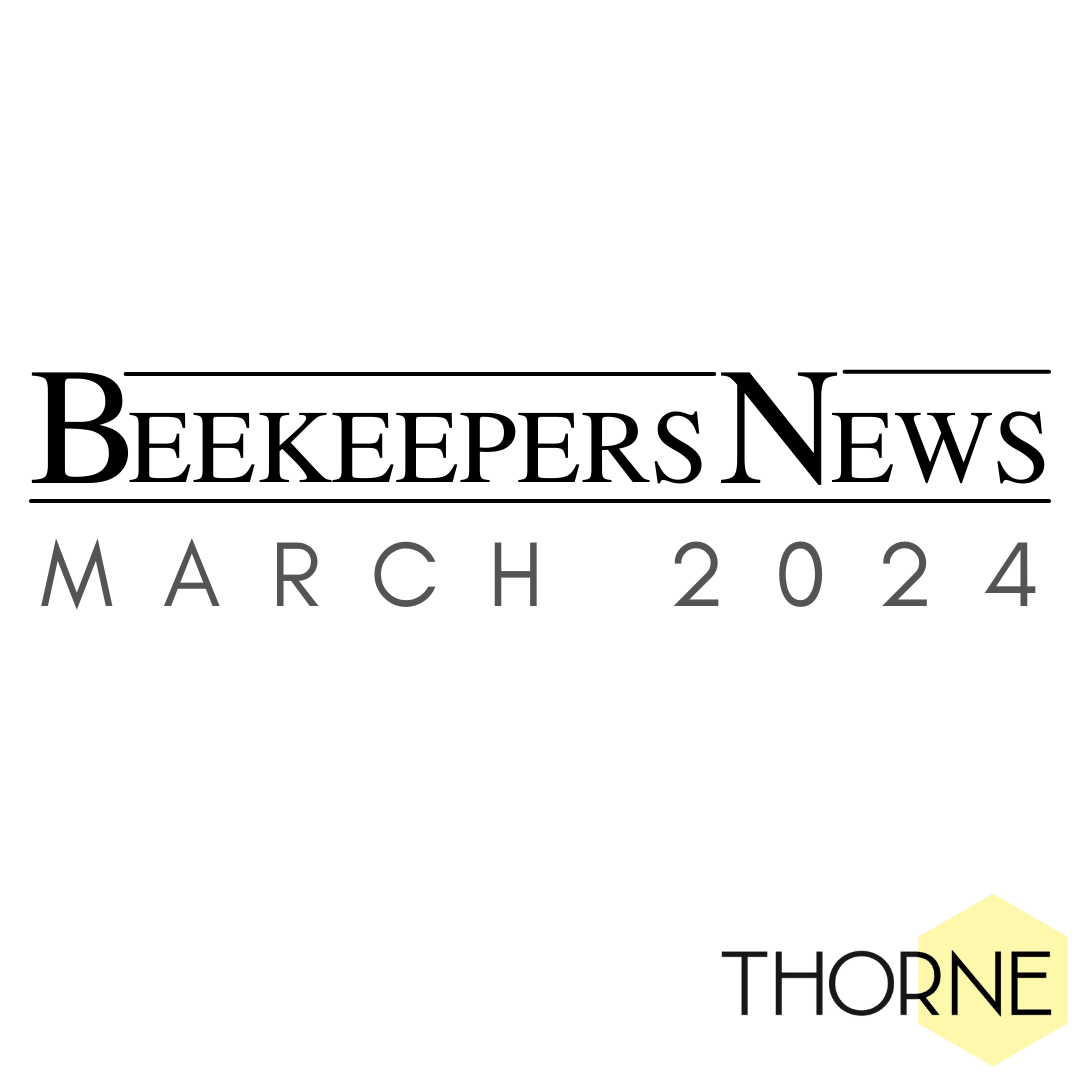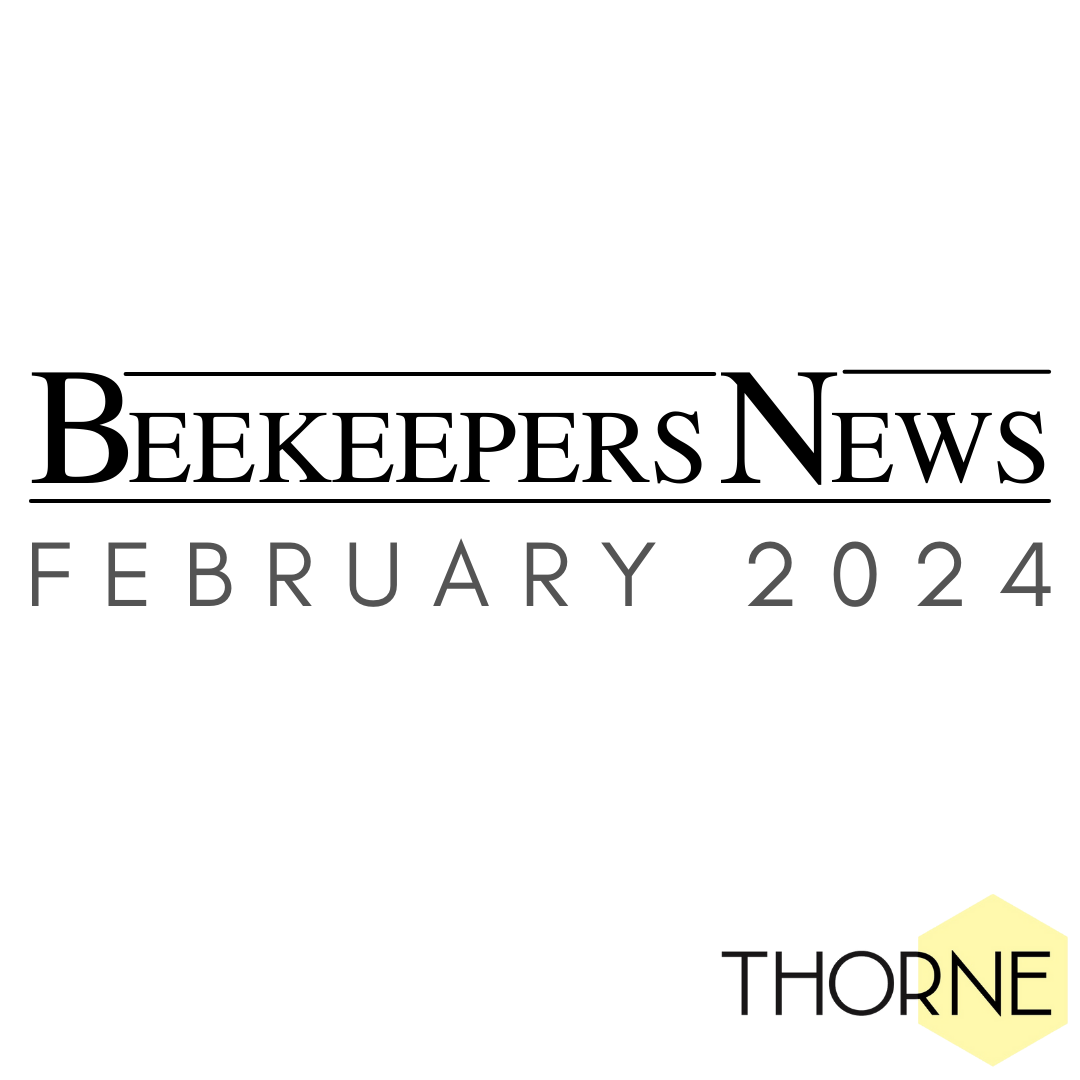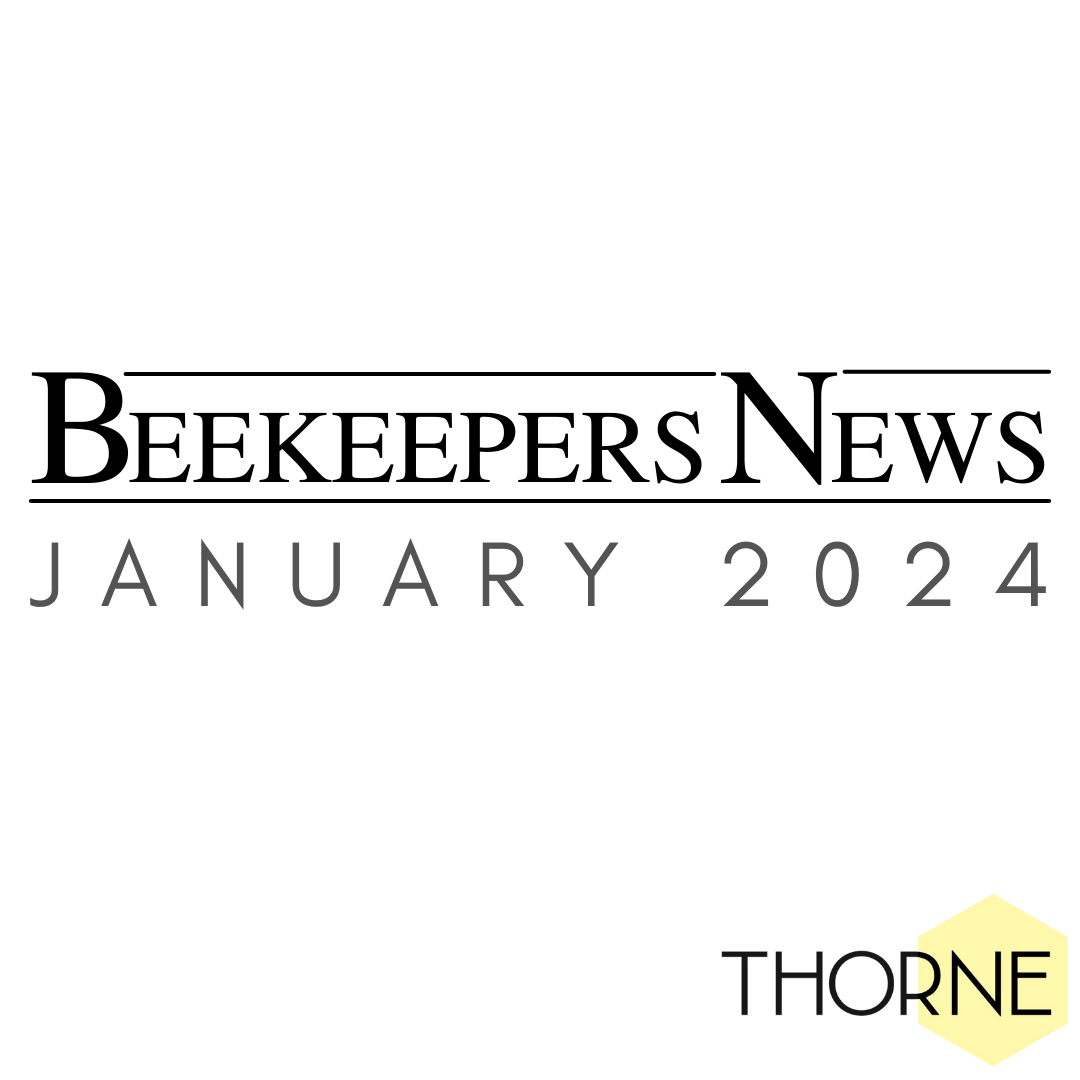September Roundup
Historically September has always been about our Windsor and Stockbridge Sale days and preparing for the main event here, at our Rand site. This year we had a little more to do with the introduction of a new sale day at our Devon shop. All three sale days had perfect weather, and happy customers collecting and browsing the many bargains on offer. A big thank you to all of our customers who came to one of the Sale Days.
The Windsor Sale Day offered the chance for some of our customers to get a sneak preview of what will be our new shop. Remaining at Oakley Green Farm, the new shop is much bigger and brighter. We had a few Thomas and Konigin Extractors on display for visitors to have a look at too!
Stockbridge Sale dawned bright and sunny and we had the usual large crowd of customers enjoying the best of Hampshire hospitality. Particular thanks to Lin and her army of volunteers who bake cakes and serve the refreshments – they always are very much appreciated.
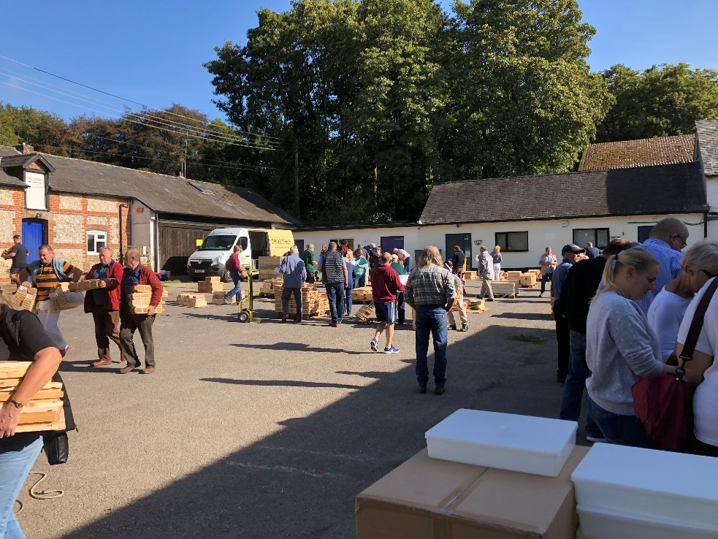
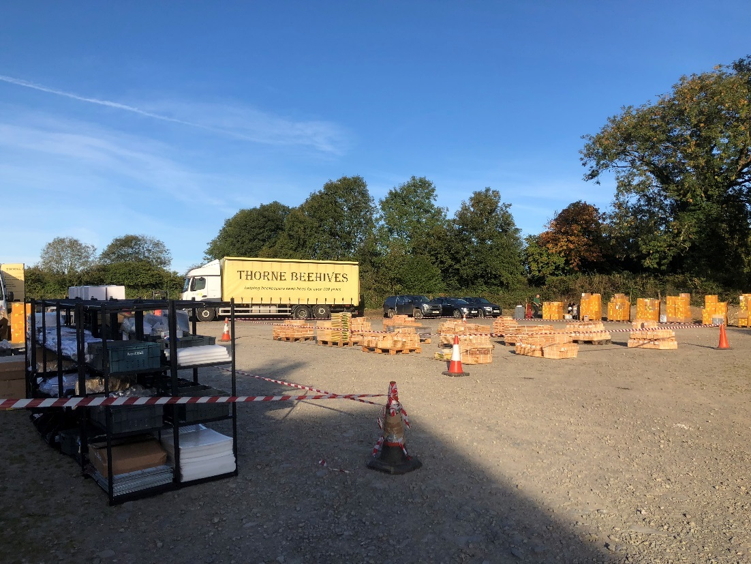
It was wonderful to meet many of our new and existing customers from the South West, at our Devon Sale Day last weekend. The picture shows us set up and ready about an hour before we opened.
If you see any Unidentified Flying Objects hovering over our site at Rand, don’t be alarmed, we simply have another type of drone using our grounds. We were recently approached by FlyBy Technology, an established drone training company, to use our site for their local training courses. Several courses later we finally had a chance to take some photos of the training in action!
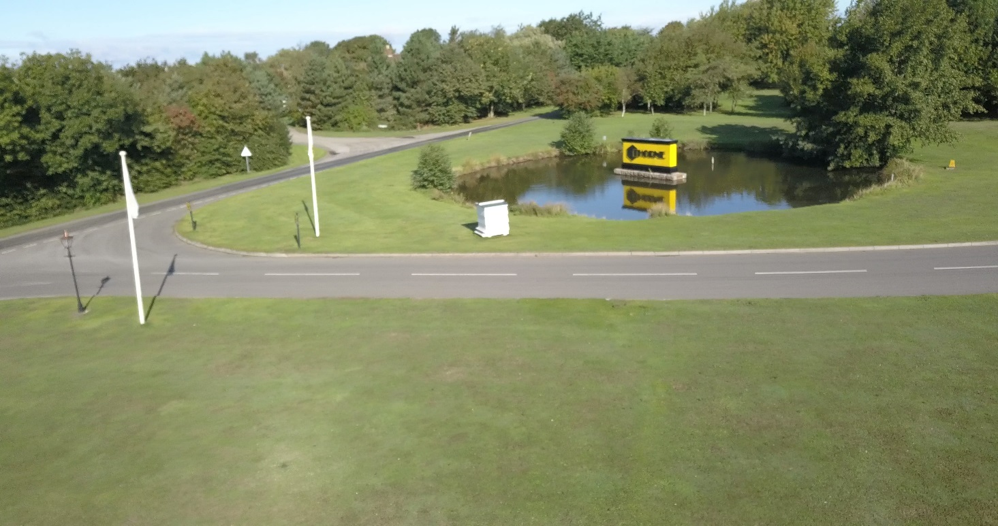
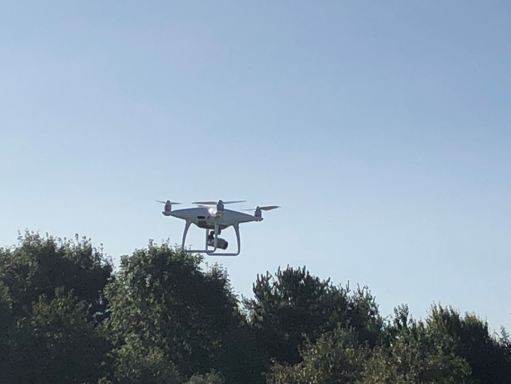
We had reason to celebrate earlier this month when John Edwards reached an incredible milestone – he has worked at Thornes for 60 years.
John joined the company as a spritely 15 year old, working for Les Thorne on various building sites before moving into the beekeeping side of the business. He quickly worked his way up to foreman and started keeping bees himself. John has been an integral part of our business for many many years and the knowledge and skills he has are unsurpassed.
We held a celebration at a local restaurant in Wragby and were joined by many faces from Thornes of old. A few photos are below, and more are on our Facebook page.
Dougie Andrew (amateur poet and expert top bar and wooden section maker) wrote and recited the following poem. It describes John perfectly.
Many congratulations John – and before anyone asks – no, he is not retiring!!
Bee T.V. by D.S. Andrew
Have you heard the story that’s going around?
There’s a T.V. celebrity in the town.
Now, nobody panic, it’s not one of Jedward,
He goes by the name of Mr John Edwards.
The Look North team were well surprised,
To hear John was still working at 75.
So they sent a lady with a camera and stand,
To interview, and film this truly great man.
He took her to the meadow to meet the bees,
They were buzzing around, amongst the trees.
He told her beware, as she knelt on the grass,
Don’t get caught out, and get stung on the *** (Elbow).
Now 60 years is a long, long time,
To be still employed and feeling fine.
He’s seen so many come and go,
He’s forgotten more than I’ll ever know.
For when it comes to beehives,
John’s the main man.
From the top of the roof,
Right down to the stand.
From the floor to the entrance,
With bees coming and going,
What John doesn’t know?
Well, it isn’t worth knowing.
It was 10 years ago now,
I wrote a line or two,
At what we thought was his retirement do.
He left on that night, tired and yawning,
But he was bloody well back on Monday morning.
So, what more can we do?
What more can we say?
Except raise a glass and say…
Hip Hip Hooray!
With a pat on the back,
And a well done mate.
For what you have achieved,
It’s truly great!
This is not the beginning,
This isn’t the end.
For there’s plenty of work,
For our dear old friend.
Retirement’s a word, that we just don’t speak,
For we know for sure John,
We will see you next week!
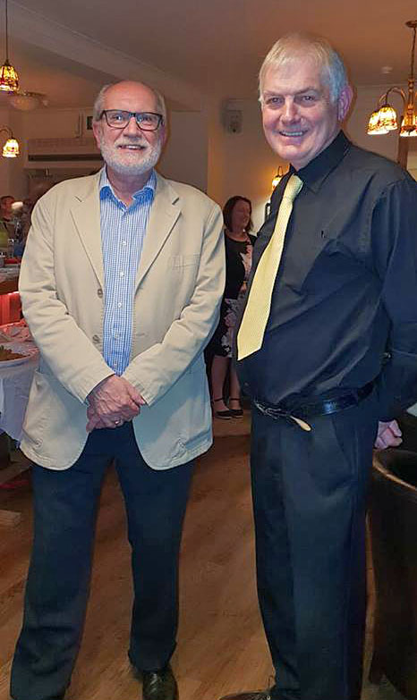
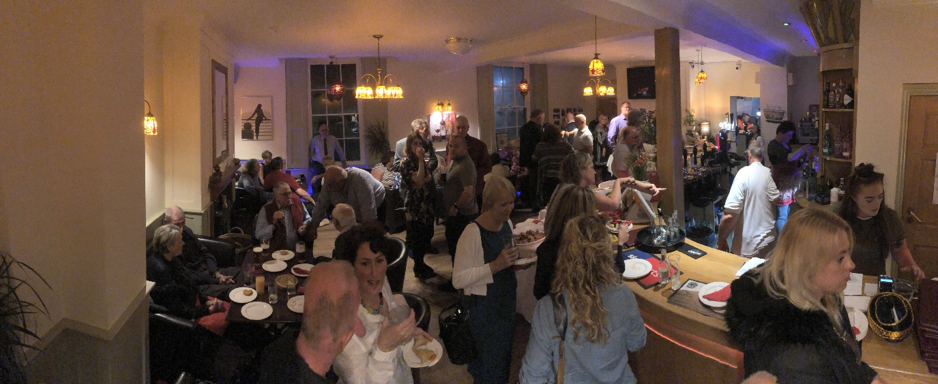
New In
We are delighted to be stocking a new oxalic acid based product for varroa treatment. The solution is applied using the trickle method and once constituted the solution has a shelf life of 12 months. Each bottle will treat a minimum of 20 hives. Introductory price is £37 per bottle. For more information see our website.
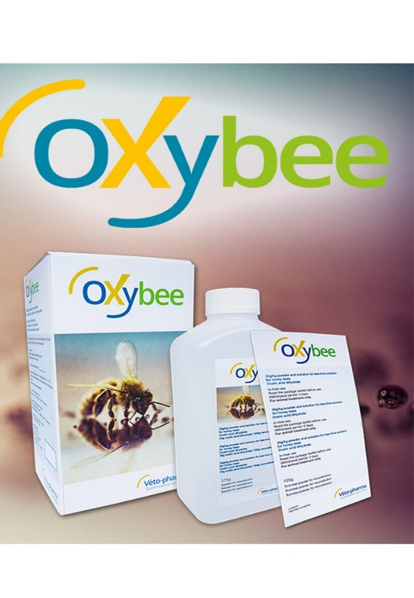
Rand Sale and Open Day – Saturday 13th October
Our annual Sale and Open Day at Rand is fast approaching and we are hard at work making sure the shop is fully stocked, the site looks immaculate, the restaurant is full of tasty delights and of course the bargains are plentiful.
The shop will be open at soon as customers begin to arrive and the main sale will begin at 10am. Included in the main sale we will have our usual second quality frames and hive parts and a decent number of shop soiled and discontinued goods (including extractors). We have decided to discontinue our Octimel range of extractors – these are available to order in advance for collection at £200. For more information and to order see our website.
We will also be holding our very popular 3rds sale. This sale will begin at 9am and the queue does start to form early. 3rds CANNOT be ordered in advance and are limited per person. For more information and prices see our website.
For any general sale enquires email sales@thorne.co.uk or call 01673858555.
National Honey Show – 25th-27th October
We are proud and delighted to be supporting the National Honey Show again this year. We will be taking a full range of equipment and will have many new items for you to look at and discuss! Goods (including sale bargains) can be ordered in advance for collection at National Honey Show.
Equipment Focus………
We have featured this essential piece of kit before in our newsletters but thought it was worth mentioning again.
Easi Steam – available in all sizes apart from WBC
This steam extractor is definitely a winner, especially as the ‘messy’ bit can be outside in the open. Now with a new style steam generator with thermal cut out this will make the chore of cleaning up frames all the more satisfying and even enjoyable! The National Easi Steam is £102.30, all other sizes are £118.00.
For more information visit our website at www.thorne.co.uk or see the Youtube video - Using a Easi-Steam
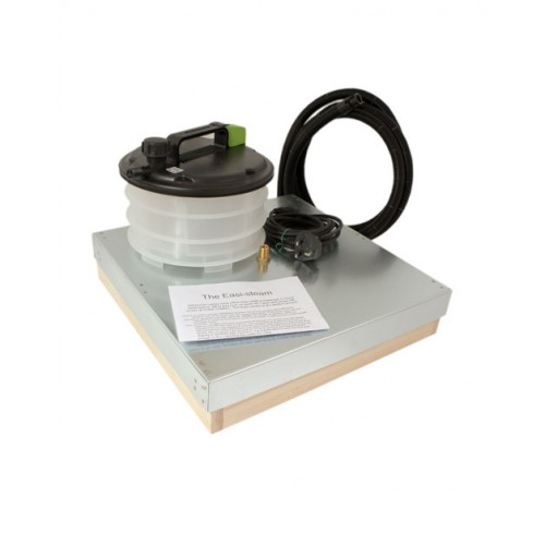
Don’t take our word for it though. Below is an article first published in Bee Craft in May 2006.
“It is not often that a new piece of equipment comes onto the market that makes changes to beekeeping procedures.
We have recently purchased an Easy Steam from the 2006-2007 Thornes catalogue and in one week have processed about 200 brood frames, which have been in our accommodation over winter. New foundation is now being put in them ready for the spring inspection.
The frames were in poor condition and were taken out of our colonies last year. Some were used to light the bonfire on 5th November and the remainder were awaiting a similar fate.
For many years now, cleaning old frames has been a chore I can do without, but this piece of kit will now change all that.
Ask our Expert
We get several questions regarding wax moth and winter storage at this time of the year. In this month’s newsletter we thought it would be worth recapping the different type of wax moth and the treatments available.
Wax moth
There are two types of wax moth that can cause problems within the beehive, the lesser and the greater wax moth. They are not generally a big problem for strong, healthy colonies but can be problematic for weaker colonies. The larvae of both species can cause damage to comb by burrowing through the wax and feeding on impurities, especially in old brood combs. Greater Wax Moth will also make furrows in wood where they have built their pit to pupate. The most obvious sign of infestation is a white silk trail left by the larvae who travel below the brood cappings. It is possible to catch these larvae but you have to be quick because they move fast!
In extreme cases the whole of the comb will be destroyed. Boxes that are lightly infested may be placed on top of a strong colony to clean out but combs that are heavily infested and beyond treatment should be burned.
Infestations are generally caused by unhygienic beekeeping practices, such as leaving burr comb and exposed supers or broods with drawn comb lying around the apiary.
There are 3 main ways to treat for wax moth. All 3 treatments can be used on drawn honeycomb supers or brood. The most common is to treat supers as brood boxes tend to have bees in over winter.
These 3 methods are outlined below.
Certan
Certan is a biological larvicide, formulated to control wax moth larvae. This is sprayed directly onto the combs after the honey harvest, in order to protect them from wax moth infestation whilst in storage. It must be eaten by the wax moth larvae to be effective and once eaten, the larvae will die 2 to 3 days later. It does not affect adult moths but does give protection against larvae right through the season. Certan will not negatively affect the bees or honey and any resistance to the product is very unlikely.
Certan is used by spraying a mixture directly on the face of the frame on each side of the comb.
How to use:
1. Dilute 10ml of Certan in 200ml of water. This amount will treat 9-11 National super or 7 Langstroth super frames.
2. Spray on to both sides of the comb on each frame.
3. Allow frames to dry before storing.
Sulphur strips (sulphur dioxide) and burner
Burning sulphur strips will kill all stages of wax moth present at the time but does not guarantee long lasting protection. It will also prevent stored pollen from going mouldy.
How to use:
1. Place a piece of newspaper on a concrete or wooden floor, preferably outside.
2. Stack 6 supers with empty combs on top of the paper and seal round the sides with tape.
3. Place an empty brood body on top of the stack.
4. Place a sulphur burner inside the brood body on top of the super frames.
5. Hang 2 sulphur strips in the sulphur burner and fold the strips in half.
6. Light the strips and quickly close the burner. When lit, the sulphur dioxide sinks through stacks of supers, treating all super frames.
7. Place a sealed hive roof over the brood body and leave quickly.
8. Repeat every 4 weeks whilst in storage and leave for a few days before putting into use.
Safety warning
Sulphur dioxide is toxic when inhaled so only use sulphur strips outside or in a well-ventilated area. Causes burns. Keep out of reach of children. Use protective clothing and seek medical assistance in case of an accident or feeling unwell.
Acetic acid
Acetic acid can be used to sterilise combs against wax moth, Nosema and chalkbrood. 80% acetic acid should be used with absorbent fume pads as well as proper protective clothing and containers because it is highly corrosive and will burn skin and corrode metal hive parts. Acetic acid cannot be sent and must be collected from one of our branches.
How to use:
1. Place an absorbent fume pad saturated with ¼ pint/125ml 80% acetic acid onto the floor. This can be a solid wooden hive floor or any timber or earth floor. Avoid concrete as acetic acid will corrode it. Remove or coat with Vaseline any metal ends or frame runners as it will corrode these parts too.
2. Place a brood box with frames to be fumigated on top of the fume pad. Then place another saturated fume pad on top of the frames. Do this for each box of frames you wish to treat.
3. Place a lid on the stack and seal the joints between the boxes with gaffer tape. As an easier alternative, it is possible to stack the boxes inside a wheelie bin liner which provides a good airtight seal.
4. Leave for 1 week. The treatment is then complete.
5. Remove the acid-soaked pads carefully and air the boxes and frames for a few days before putting into use.
Safety Warning
Acetic acid is highly corrosive and will easily corrode concrete and burn skin. Avoid contact with the eyes and fumes being inhaled into the lungs. Always wear overalls, protective gloves and goggles when using this acid.
Beekeeping Blog
September
After sightings of the Asian Hornet this month in Cornwall and Hull, we have been keeping a close eye on the situation in our own apiaries. We have emptied and refilled our Asian Hornet traps and will be monitoring these with increased vigilance. It is really important that everyone looks out for this invasive pest which could decimate our honeybee colonies. Identification is key so here I include a link to the National Bee Unit page on Asian Hornet where you can find ID posters and information on what to look out for: http://www.nationalbeeunit.com/index.cfm?sectionid=117
We have done full inspections of the hives this month and fed any that didn’t have sufficient stores for the time of year. This will give them chance to build up so that they can go into the winter months nice and strong. Last month, we treated for varroa using Apivar. One reason we chose this particular treatment was because it can be used whilst feeding, which can be critical going in to winter to prepare the bees with stores.
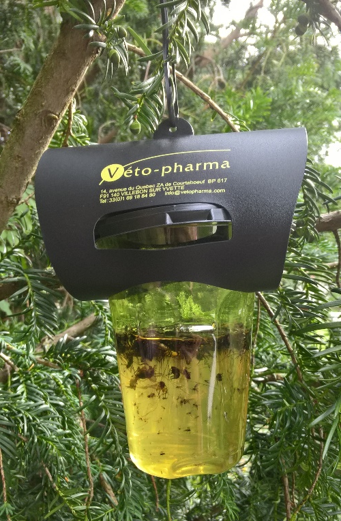
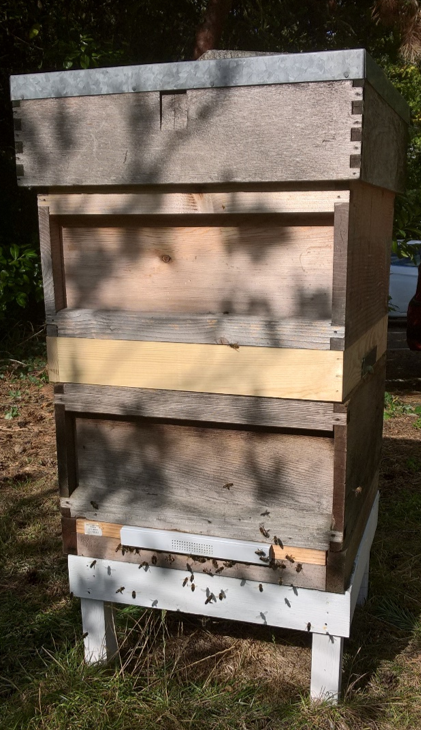
We have also united a hive which had become queenless and without intervention, would have died over winter. Luckily, we had a nucleus ready to go with a laying queen that we could merge with the queenless hive. Instead of using the normal newspaper method, we experimented using the Adapta Eke with a mesh screen to unite them. From the picture, you can see it looks just like a normal eke, but inside it has a mesh insert which acts as a barrier through which smells can pass through. This gives both colonies a chance to get used to each other without being able to kill each other. After a few days, we removed the Adapta Eke and let the bees merge together. This seemed to work well as the bees did not fight and are now living harmoniously as one colony.
Moving into next month, we will be looking to attach mouseguards to the front of our hives. As yet, bees are still bringing in plenty of pollen. Mouseguards can knock pollen off the bees’ legs so we will wait until less pollen is being brought in before attaching them.
If you require any more information, please send an email to Alexandra at sasha@thorne.co.uk who will be happy to help or call one of our sales team on 01673 858555.
Bees for Development Update
Bees for Development Ethiopia and Bahir Dar University are investigating the impact of agrochemicals on honey bees in the intensively farmed areas of Amhara in northern Ethiopia. All beekeepers interviewed said that they had observed honey bee poisoning: 54% have witnessed dead bees in the fields after spraying; 38% have seen evidence of bee deaths at the hive entrances; and 8% interpret bee deaths they have seen inside the hive as being due to poisoning.
Other findings from the study revealed that use of pesticides is such common practice that beekeepers use them just as frequently as non-beekeepers, because they do not know what else to do. Malathion is a wide-spectrum organophosphate insecticide, widely used in Ethiopia - indeed Ethiopia has a chemical plant which makes its own Malathion - called Ethio-lathion.

Even more surprisingly, our survey revealed that most farmers had little understanding of the pollination services provided by bees. This problem analysis is helping us to design our future work priorities.
11 October Fortnum & Mason Honey Auction & Dinner
Fortnum & Mason are celebrating ten years of having beehives on the roof of their Piccadilly store, and other buildings across London, with a very special occasion. Their limited edition honeys – made by bees in hives across the capital – go under the hammer at their annual auction, this year hosted by broadcaster and beekeeper, BfD’s super-Patron Bill Turnbull. The auction will be accompanied by a special charity dinner in support of Bees for Development, with honey at the heart of the menu, served with cocktails including F&M’s new honey-infused gin. Last few tickets still available: https://www.eventbrite.co.uk/e/honey-auction-dinner-tickets-49983691567
25-27 October UK National Honey Show
Coming to this month’s National Honey Show at Sandown Park? Do not miss BfD’s famous Fun Bee Quiz with wine and supper on Friday evening, hosted again by our super-Patron Bill Turnbull. This is THE best way to spend Friday evening! Good company and supporting Bees for Development. Come on your own or come as a team. Early-bird tickets are £20 and available now 01600 714848 www.beesfordevelopment.org
Bees for Development 25th Birthday - October Giveaway
Our Birthday Giveaway prize for October is a Cider & Stay experience in the Wye Valley, consisting of a one night break at the historic Deanfield Bed & Breakfast in the Forest of Dean and a case of traditional cider from Ross on Wye Cider & Perry Company.
Built in 1840 and originally home to the village Quarry Master, you will experience both history and luxury when staying in Deanfield’s superking en-suite Bluebell Room. Backing onto an RSPB Nature Reserve, there are plenty of local activities to keep you busy. www.deanfield.org.uk.
Included in October’s prize is a case of Herefordshire cider from Ross on Wye Cider & Perry Company. Pressed at Broome Farm since the 1930s, this whole juice cider is naturally fermented and produced traditionally, allowing for small batches. Collect your case from their Cider Shop where you can taste from a selection of between thirty and sixty different single varieties and blends. www.rosscider.com. To win this treat, just enter: here. Of course any visit to the Wye Valley would not be complete without visiting Bees for Development here in Monmouth!
Kevin Harris is last month’s winner, receiving two vouchers for Courses on Humble by Nature, the working farm owned by broadcaster and writer Kate Humble, with wonderful bed and breakfast at The Inn at Penallt.
National Honey Show News
Firstly, a reminder that entries need to be booked in i.e. forms sent to our entries sec entries@honeyshow.co.uk by Monday 8th October. Late entries can be accepted up to 15th October but incur a late entry fee. Details and forms are on the website: https://www.honeyshow.co.uk/download-schedule.php with a link to a *new* comprehensive guidance for oversees exhibitors on the same web page. Remember Thornes shops plus other volunteers will deliver your entries Wednesday afternoon 24th October if you book them in in good time.
As well as the usual dazzling programme of lectures and workshops, there are several satellite events open to visitors.
If you want to join up with other beekeepers during the evenings, on Thursday evening, The Central Association of Beekeepers are holding a social evening five minutes walk from the show with a talk: “What more than ten years of surveys have told us about global honey bee colony losses” presented by Norman Carreck, followed by finger buffet and drinks. Tickets (£20) can be booked on line at www.cabk.org.uk/product/social-evening-2018/ or at the CABK stand at the show itself.
On the Friday evening you can sign up for good company and to support Bees for Development for their Quiz hosted by Bill Turnbull. It’s held in the Sandown Park Food Hall at 6pm, Tickets £20 available at www.beesfordevelopment.org or from the Bees for Development stand at the show itself.
This year, several people associated with the show have published books, and Northern Bee Books in their new, grandstand position in the “Champagne Bar” will be hosting two book signing sessions 12.30pm Friday and 10.30am Saturday. You can come along, bring your coffee, and chat with the authors while getting your book(s) signed. These new books include ‘Making Beeswax Flowers’ by Liz Duffin; ‘Planting for Honeybees: The Grower's Guide to Creating a Buzz’ by Sarah Wyndham-Lewis. Both of those authors will be holding workshops at the show. The new edition of Norman Chapman’s “Pollen Microscopy” will be published at the show and he will be available to sign copies, as will our lecturer Clarence Collison whose new book “A Closer Look: Basic Honey Bee Biology” was published earlier this year. There may be others as well.
You can also pre-book all your 2019 beekeeping equipment for collection at the show, it makes sense to plan ahead and take advantage of the amazing parking facilities and get the best from this fantastic show.
The National Honey Show, 25 to 27 October 2018, Sandown Park Racecourse, Esher, KT10 9AJ www.honeyshow.co.uk.
Upcoming Events
Sale items to order for collection at our Rand Sale and Open Day and the National Honey Show are live on our website – www.thorne.co.uk/sale-days
Rand Open and Sale Day Saturday 13th October
National Honey Show 25th to 27th October
Winter Sale (starts online) Midnight Friday 28th December
